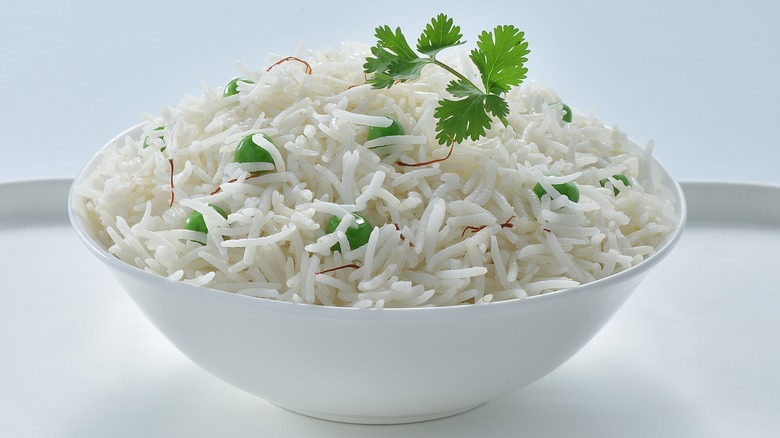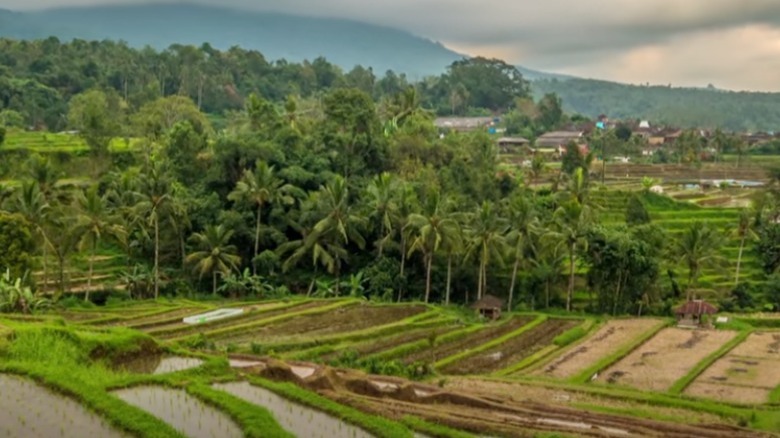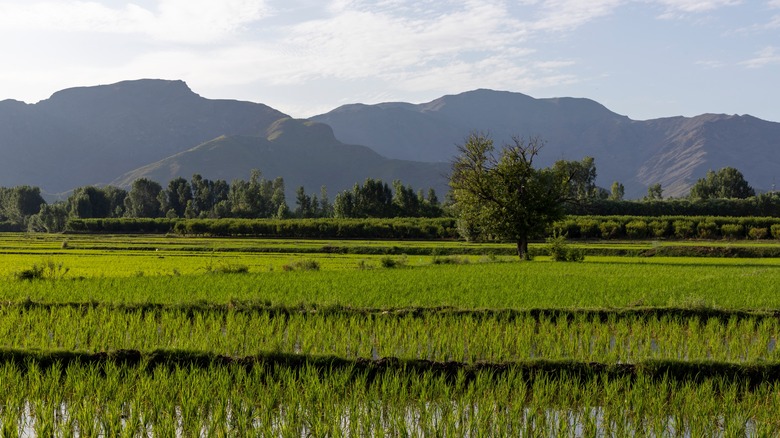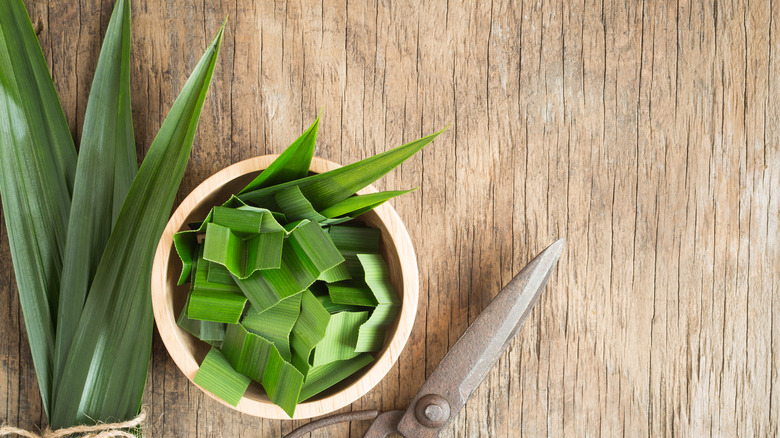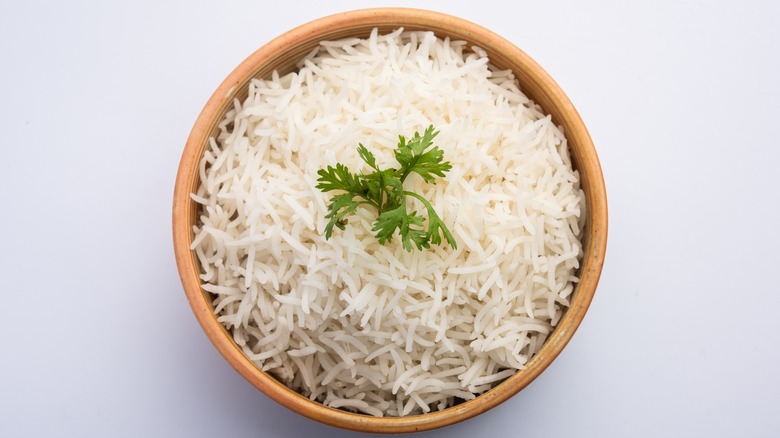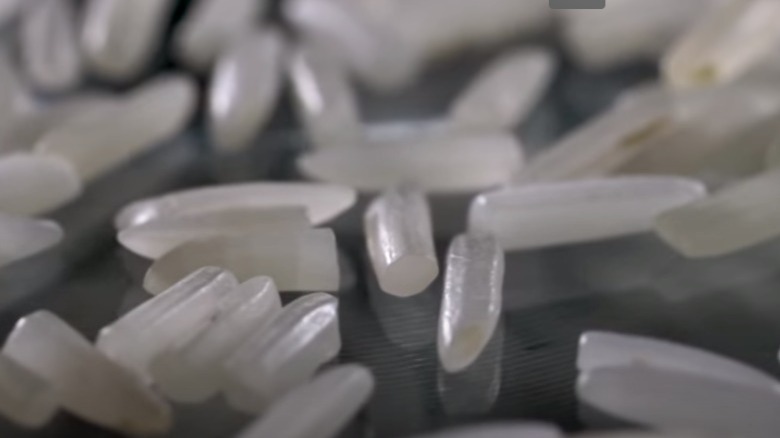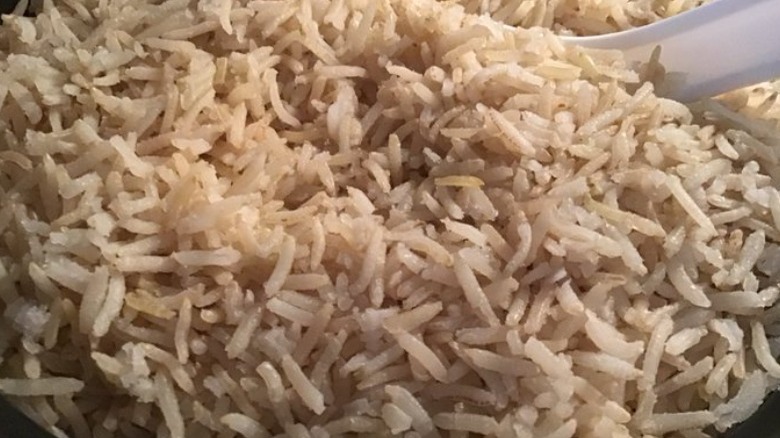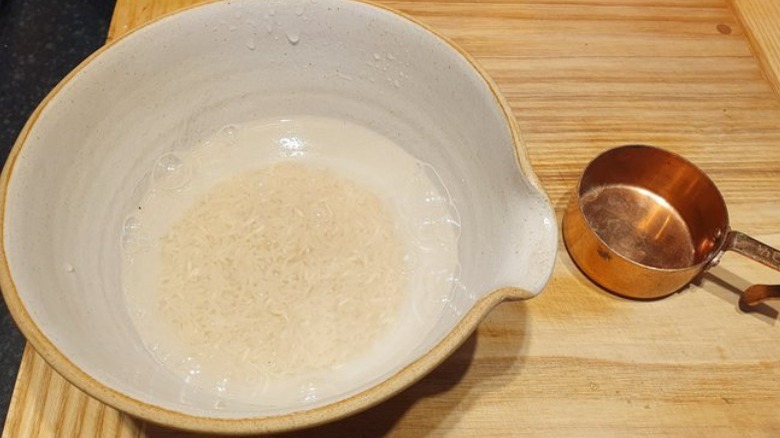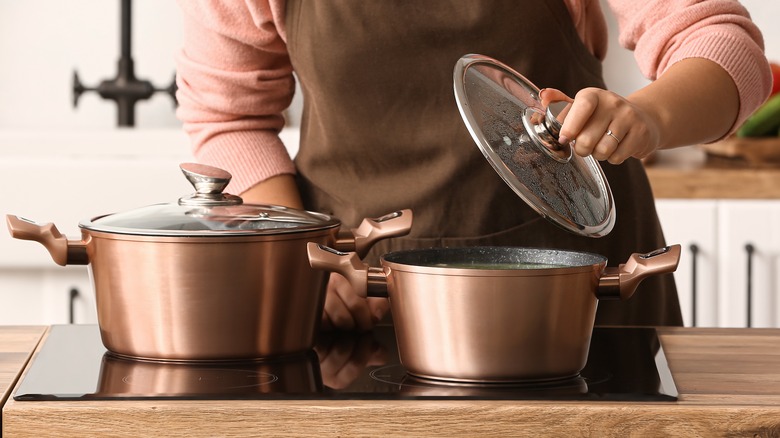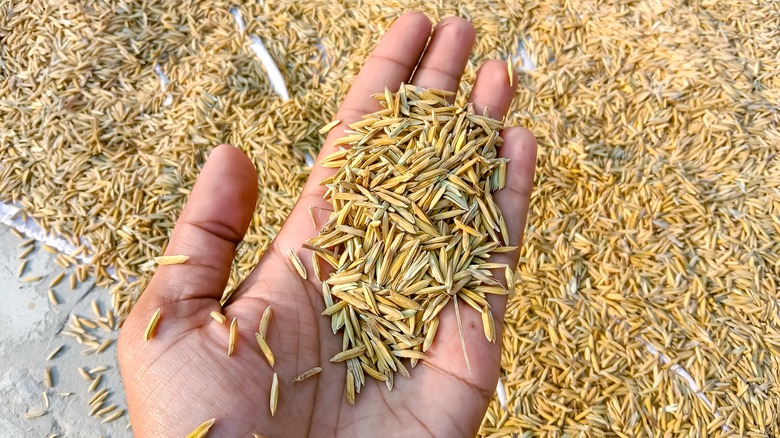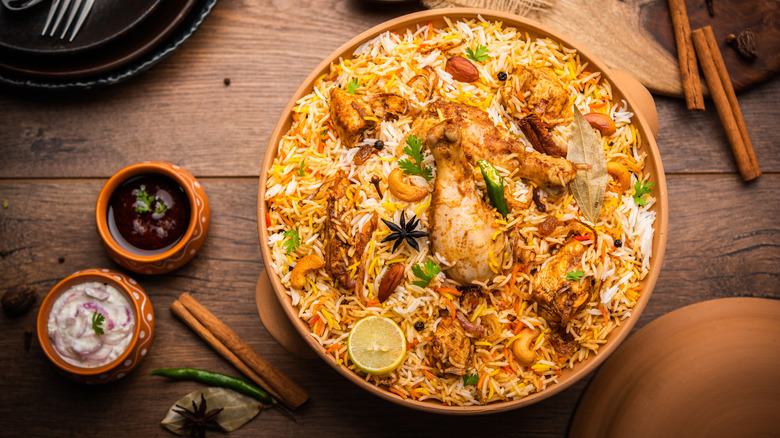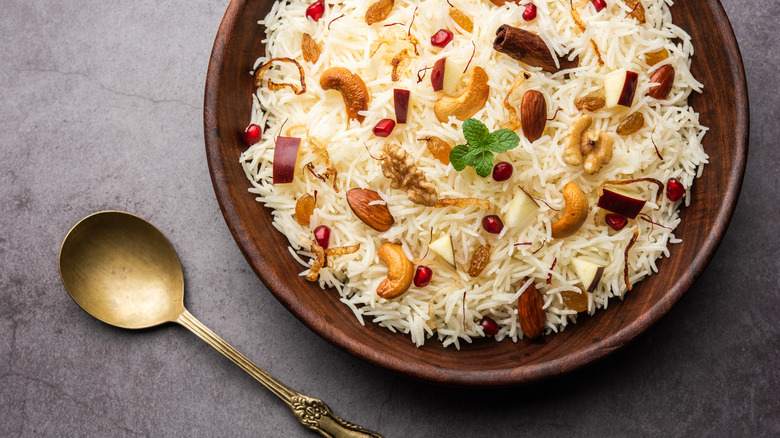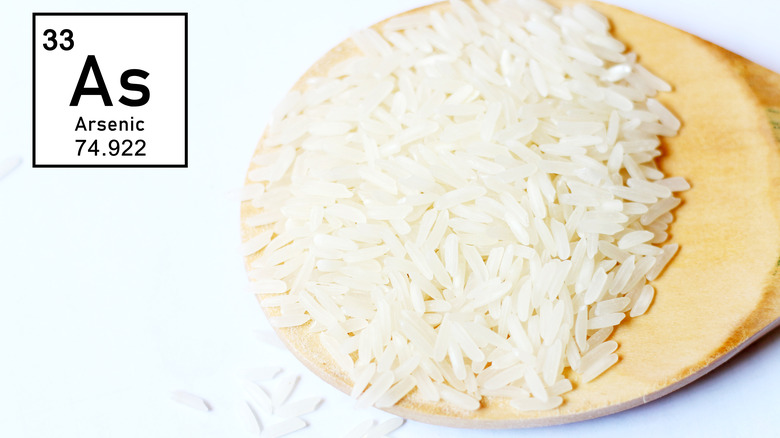The Ultimate Guide To Basmati Rice
Basmati rice has become one of the world's most beloved types of rice. Its long grains, buttery fragrance, and fluffy yet distinct grain texture make it unique among rices. Because early basmati was so difficult to grow and only thrived in a specific climate, it was a dish that only royalty and the wealthy could afford. However, with new innovations, it's become a type of rice that the whole world can enjoy.
While you may have first encountered it as a base for Indian cuisine, basmati rice tastes great any time. It also has some attributes that make it healthier to consume than most other types of white rice. For example, it has a lower glycemic index than most types of white rice and tends to have less arsenic in it than most other types of rice. Let's look more closely at what makes basmati rice so unique, what to look for when you buy it, and how to prepare it for optimal enjoyment.
Basmati's history goes back a long way
Rice has been a part of Indian cuisine since ancient times, with the earliest remains of rice showing up in neolithic pottery from over 8,000 years ago. These remains were found in the city of Mahagara in Uttar Pradesh, which is part of the Indo-Gangetic Plain where basmati rice currently grows.
While rice was mentioned generically in the "Atharva-Veda" in 1500 B.C., it wasn't until 1766 C.E. that basmati rice shows up the epic tale of "Heer and Ranjha." The author of the story is Varish Shah, who is from Punjab, placing basmati rice firmly in the Indo-Gangetic Plain.
Even though we don't see basmati rice by name in earlier literature doesn't necessarily mean that basmati rice is a newer variety. However, because of the difficulty growing it, early basmati was a luxury rice that only royalty and the wealthy consumed. So although basmati may have been around for a long time before it showed up in Indian literature, it was not the rice of the commoner until advanced technology made it easier to grow.
Basmati rice was initially only grown in one area of the world
Basmati rice needs very specific growing conditions to thrive, including the right type of soil and weather. Archeological and historical records indicate that basmati first developed in the Indo-Gangetic Plain, located southeast of the Himalaya mountains and northwest of the Great Indian Desert. Having the perfect weather at the right stages of the growing process gives the rice its distinctive flavor and fragrance.
The rice of the region evolved over time, with humans choosing desirable cultivars that eventually became aromatic basmati. Unfortunately, early basmati plants were extremely tall, causing them to bend in high winds such as monsoon winds. Basmati rice initially had a notoriously low yield because bent rice plants are more susceptible to disease and are more difficult to harvest. So, only royalty and the wealthy could afford the rice. However, in the 1960s, modern basmati was bred to be more robust, shorter, easier to harvest, and take less time to grow. With such improvements, it is no longer a low-yield crop that is overly expensive to produce.
India isn't the only place that grows basmati rice
Initially, India was the only place that grew basmati rice since it first evolved and was cultivated there. However, with the creation of Pakistan in 1947, some of the areas where basmati grew legally ceased to belong to India anymore. Today, world rice consumers buy 72% of its basmati rice from India, and Pakistan produces most of the rest.
Interestingly, the Indo-Gangetic Plain isn't the only place in the world with ideal conditions for growing basmati rice, especially now that it has been cultivated to be easier to grow. Nearby Nepal is able to grow basmati, but they don't export it. Meanwhile, countries like Sri Lanka have tried growing it with limited success. It also turns out that industrious farmers have successfully tried their hands at basmati in countries as far away as Kenya and Indonesia. In fact, Indonesia is hoping its basmati rice will eventually overtake India in sales numbers now that they have varieties that can grow in both the highlands and lowlands.
Basmati rice's pleasant aroma comes from a specific chemical compound
One characteristic that sets basmati apart from other rice varieties is its popcorn and floral-like aroma. This scent comes from 2-acetyl 1-pyrroline (2AP), which consequently is the same chemical found in popped popcorn. If you've ever thought jasmine rice is similar to basmati rice in smell, it's because they both release 2AP when they cook. Some other foods which get their scent from 2AP include pistachio nuts, sauteed mushrooms, rye bread crusts, and pandan leaves (often added to rice to make it more fragrant). Interestingly, 2AP is the chemical compound that provides the flavor we crave from items that have turned golden brown through the Maillard reaction.
2AP is an extremely volatile chemical, which means that it evaporates easily into the air. It only takes pure 2AP 10 minutes at room temperature before the scent starts to dissipate. In northern India, basmati rice flowers at the beginning of October, ushering in the harvest season that continues through the end of December. Unfortunately, if the temperature gets too hot during harvest time, the flavor of the rice suffers because the 2AP aroma will evaporate and begin to disappear.
Thus, if you end up purchasing a bag of basmati rice that isn't very fragrant, it has likely been overheated somewhere between the field and your home. To keep your basmati rice as fragrant as possible, it's a good idea to keep it in a cool place or even refrigerate it.
Basmati's texture is distinctive
One of the crowning attributes of basmati is its ability to stay both soft and fluffy while the grains stay distinctly separate from each other. So, if you like the softness of sticky long-grain rice but the distinctive rice grains you find in products like Uncle Ben's converted rice, basmati rice can give you the best of both worlds at the same time.
The content of a particular rice starch chemical called amylose controls whether your rice is overly sticky, overly hard, or just right. The sweet spot for fluffy basmati rice happens when the rice contains between 20% and 25% amylose. Any less, and the rice will be sticky. Any more, and the rice will be hard.
Basmati rice producers have learned that aging basmati rice for two years allows the rice to reach the perfect level of amylose for perfectly fluffy rice. When you age rice, the rice significantly increases in volume, weight, and length when you cook it. So, aged rice goes further for the consumer. Unfortunately for the producer, aging basmati rice is costly since it takes up so much space for so long in gigantic temperature- and humidity-controlled warehouses, requiring frequent aeration and inspection.
Not all basmati is created equally
Unfortunately, not all rice labeled as "basmati" is true basmati. In the late 1990s, a U.S. rice company called RiceTec received a patent for call its aromatic rice "basmati." Since it would prevent true basmati from being labeled as "basmati" in the U.S., the Indian government brought the issue before the World Trade Organization and won. Through the process, India realized over 90% of worldwide consumers were buying fake basmati.
India has defined basmati rice as being at least 2.6-3 millimeters long, being at least three times as long as it is wide, and being transparent and milky white before the aging process. After cooking, the rice grains should at least double in volume, be soft and fluffy, and be separate rather than sticky. And, of course, it should also produce a distinctive, buttery-floral fragrance when you cook it. If your basmati rice doesn't match these parameters, you've been duped.
Many good-quality basmati brands come in cloth or burlap bags. However, if it comes in a clear plastic bag, you can inspect it a little more closely to ensure the rice grains look as they should. The grains should be round rather than flat. They should also be long and tapered at the end rather than short and blunt, indicating they've been broken. The aging process makes basmati rice a little closer to golden, so purchasing any that's bright white or gray means you're not getting basmati or it hasn't been aged to perfection.
There are three types of basmati rice
The three types of basmati rice available are raw, parboiled, or brown. Most of us are the most familiar with raw basmati rice. Raw basmati has not undergone any type of cooking before it shows up in the grocery store and has no outer husks. It starts out pearly white and translucent but turns somewhat golden during the aging process.
At some point during the history of basmati rice, producers realized that they could parboil it before packaging it to make it stronger. The process involves steaming and soaking the rice to make it more robust. So, if you want to make a dish like biryani that takes a long time to cook at high temperatures in the oven, you'll want to look for parboiled basmati rice (also called sella). Parboiled basmati can withstand longer cooking times and higher temperatures than raw basmati, while keeping its distinct-grain texture and fluffiness. Thus, it doesn't turn to mush like some other rice varieties in the same cooking scenario.
The third type of basmati is brown basmati rice, which is how basmati comes before removing the outer husk. Because the husk remains on brown basmati, it has a higher nutritional content, including more fiber from the intact outer layer. You'll find that brown basmati has more of a nutty flavor than other types of basmati.
Rinsing and soaking are important parts of making fluffy basmati rice
Not all rice requires soaking and rinsing in cool water, but basmati rice does. Whatever you do, please don't skip this step in basmati rice preparation if you want fluffy rice. Unlike lentils, the point of rinsing and soaking rice isn't about removing debris since the rice is cleaned during the milling process. Instead, the process has two culinary purposes. Removing excess starch during rinsing prevents the grains from sticking together, while the water absorbed during soaking speeds up the cooking time.
If you're in a hurry and aren't concerned about getting the perfect rice, it's fine to soak the rice just for the amount of time that you are waiting for your water to come to a boil on the stove. We suggest soaking and rinsing a few times to get as much of the starch off as you can. However, the ideal amount of time to soak your basmati for perfectly fluffy rice is 30 minutes before cooking.
Nutritionist Shonali Sabherwal told HuffPost that soaking and rinsing basmati rice before cooking removes phytic acid. If the phytic acid remains in the rice, it prevents your body from absorbing nutrients like calcium and iron that are present in it.
There's a right way to cook and prepare basmati rice
After you have soaked your rice, the cooking process doesn't take long. Some cooks add a pinch of salt and a bit of olive oil or butter. We're including methods for cooking white and brown basmati rice on both the stovetop and in an Instant Pot.
For stovetop preparation, the ratio of pre-soaked rice to water or broth should range from 1:2 or 1:2.25. So, for every cup of rice, you will be adding two to two and a quarter cups of water. Always add the rice to boiling liquid. Once you've added the rice to the boiling water, turn down the heat to a simmer and cover the pot with a lid. If you soak your rice for 15-30 minutes before cooking, then it should only take white basmati rice 10-15 minutes to cook. However, brown basmati rice will take 30-35 minutes to cook. After you remove the rice from the heat, keep the lid on the pot to allow it to steam and further for about 5 minutes before serving.
If you're making basmati rice in an Instant Pot, the ratio of water or broth to pre-soaked rice is 1:1. After you put on the lid, you'll cook it at high pressure for six minutes for white basmati rice or 22 minutes for brown basmati rice. After the cooking has ended, it will need a 10-minute natural pressure release.
Basmati rice husks have a usage
Before basmati rice processors remove it from the rice, the husk makes up 20-24% of the rice's total weight. So plants that process basmati rice are left with mountains of husks. Rather than throw them in a landfill, it has been advantageous for rice producers to find ways to use them. For a long while, they were just made into cow feed, but it turns out that they're even more versatile.
Many basmati rice factories actually use rice hulls as fuel, which provides some of the plant's electricity, or for steam during the parboiling process. It's also possible to buy rice hull pellets or briquettes to use as solid fuel. Once rice hulls have been burned, the remaining ash is helpful to add to soil for gardening purposes, and industries purchase rice husk ash to add to steel and cement. Rice hulls themselves are useful for home brewing, mulch, and animal bedding.
It's also possible to turn rice husks into a chemical called furfural, which is used in the oil refinery industry, as well as for making synthetic rubber and nylon. Furfural is also used to make an ingredient found in food flavorings and perfumes. The scent and flavor have been described as being similar to almonds.
Basmati rice provides several health benefits
Like most rice, basmati is high in calories and carbohydrates. However, both white basmati rice and brown basmati rice have a lot of vitamins and minerals. To be able to absorb some of these nutrients, you will need to soak and rinse the rice to remove phytic acid.
A serving of white basmati rice is one cup and contains 210 delicious calories, along with 45.6 grams of carbohydrates. Unfortunately, white basmati rice doesn't have a lot of fiber without its outer husk. Still, there are a surprising number of vitamins and minerals in white basmati rice. A serving of basmati rice has more folate, thiamine, and selenium than anything else, weighing in at 22-24% of the amount you need each day. It also contains niacin, copper, iron, vitamin B6, zinc, phosphorus, and magnesium.
With the addition of the outer husk, a serving of brown basmati rice has 38 more calories and 5.8 more grams of carbs. However, it also contains almost twice as much fiber (3.23 grams), which is good for digestive health. Brown basmati also contains slightly more of some vitamins and minerals like magnesium, zinc, and potassium.
Basmati rice has a lower glycemic index than some other types of white rice
A food's glycemic index shows how much it will increase your body's blood sugar level after you eat it. Harvard says that the glycemic index of rice tends to fall between 48 at the lowest and 93 at the highest. If you like white rice better than whole grain rice, you'll be happy to know that basmati has the lowest glycemic index of any white rice, falling between 50 and 58 (via WebMD). If you have diabetes or follow a diet that requires you to pay attention to how much a food will increase your blood sugar level, eating small quantities of basmati rice may be an option for you.
Even if you're not concerned about your blood sugar level, a 2014 study in the American Journal of Clinical Nutrition indicates that eating foods with a lower glycemic index may also help with losing weight and controlling blood sugar levels. Meanwhile, a 2013 study in the Family Practice journal indicates that eating foods with lower glycemic indexes may help lower cholesterol levels.
Basmati rice has less arsenic than most other types of rice
If you've consumed enough fiction in books and on television, you probably are familiar with the idea of arsenic as a deadly poison. However, most arsenic poisoning is slow-acting when introduced in small amounts in food and water, ultimately causing cancer, heart-related diseases, high blood pressure, or diabetes. In children and teens, arsenic poisoning may cause impaired brain function (via Healthline).
Most food and drinks we consume contain small amounts of arsenic because arsenic is a naturally occurring element in water and soil. However, the real problem comes from contamination with inorganic rather than organic arsenic. Unfortunately, rice is among the foods most likely to retain larger amounts of the bad kind of arsenic. Since rice sits in wet fields for long periods, it's more susceptible to taking in any arsenic that may be in the soil, water, and farming chemicals.
A 2014 Consumer Reports study showed that rice from India, Pakistan, and California had less arsenic than rice from Arkansas, Louisiana, and Texas. Specifically, they found that basmati rice has about half as much arsenic than other types of rice, whether grown organically or not. Further, a 2006 study in the Food and Chemical Toxicology journal also indicates that rinsing with low-arsenic water removes 28% of any arsenic in rice, which is yet another reason to soak and rinse basmati rice.
